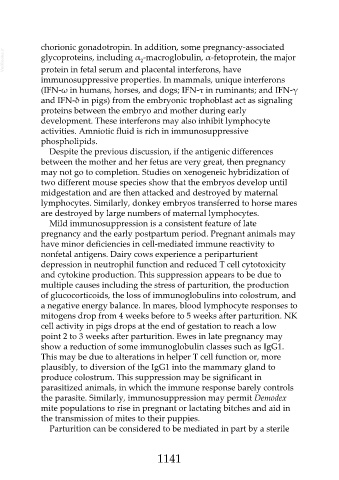Page 1141 - Veterinary Immunology, 10th Edition
P. 1141
chorionic gonadotropin. In addition, some pregnancy-associated
VetBooks.ir glycoproteins, including α -macroglobulin, α-fetoprotein, the major
2
protein in fetal serum and placental interferons, have
immunosuppressive properties. In mammals, unique interferons
(IFN-ω in humans, horses, and dogs; IFN-τ in ruminants; and IFN-γ
and IFN-δ in pigs) from the embryonic trophoblast act as signaling
proteins between the embryo and mother during early
development. These interferons may also inhibit lymphocyte
activities. Amniotic fluid is rich in immunosuppressive
phospholipids.
Despite the previous discussion, if the antigenic differences
between the mother and her fetus are very great, then pregnancy
may not go to completion. Studies on xenogeneic hybridization of
two different mouse species show that the embryos develop until
midgestation and are then attacked and destroyed by maternal
lymphocytes. Similarly, donkey embryos transferred to horse mares
are destroyed by large numbers of maternal lymphocytes.
Mild immunosuppression is a consistent feature of late
pregnancy and the early postpartum period. Pregnant animals may
have minor deficiencies in cell-mediated immune reactivity to
nonfetal antigens. Dairy cows experience a periparturient
depression in neutrophil function and reduced T cell cytotoxicity
and cytokine production. This suppression appears to be due to
multiple causes including the stress of parturition, the production
of glucocorticoids, the loss of immunoglobulins into colostrum, and
a negative energy balance. In mares, blood lymphocyte responses to
mitogens drop from 4 weeks before to 5 weeks after parturition. NK
cell activity in pigs drops at the end of gestation to reach a low
point 2 to 3 weeks after parturition. Ewes in late pregnancy may
show a reduction of some immunoglobulin classes such as IgG1.
This may be due to alterations in helper T cell function or, more
plausibly, to diversion of the IgG1 into the mammary gland to
produce colostrum. This suppression may be significant in
parasitized animals, in which the immune response barely controls
the parasite. Similarly, immunosuppression may permit Demodex
mite populations to rise in pregnant or lactating bitches and aid in
the transmission of mites to their puppies.
Parturition can be considered to be mediated in part by a sterile
1141

